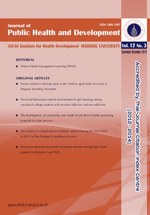Health Literacy of Village Health Volunteer in Municipalitiy, Nakhonratchasima, Thailand
Main Article Content
Abstract
Health literacy is an important health determinant because a person who has low health literacy always gets the poor
health and dies earlier than usual. Although Thai’s village health volunteers (VHV) have been continuously training in
order to take care of community health, the VHVs in urban of Thailand have never been measured the level of their health
literacy. This study aims to measure of VHVs’ health literacy and to classify VHVs by levels of their health literacyfor
planning to improve VHVs’ health literacy in urban area. A cross-sectional study was conducted during April 2013-October
2014. The data were collected by self-administered questionnaire. Of total 1,731 VHVs from 3 municipalities,1,710
answered the questionnaire; the response rate was 98.8 %. It was divided into 1,402 of Nakhon Ratchasima city municipal
(NH) VHVs, 201 of Joho municipal district (JM) VHVs, and 107 of Huatalae municipal district (HM) VHVs. Descriptive
statistics and cluster analysis (K-Mean procedure) were applied to analyze data.
Overall participants were 1,710 VHVs whom met inclusion criterion. The ratio male:female was 1:6. The mean age
was 54.4 (11.0) years and the mean duration of working as VHVs was 8.3 (5.9) years. They graduated as elementary school
level as 45.9%. The main income was from private business. Of those, 57.1% had chronic disease. Literacy and the ability
of VHVs were good level except writing message for other to understand, reading comprehension, seeing things clearly,and
overall health status, which were moderate level. For all 14 aspects of health literacy, VHVs obtained 7.8-8.9 points from
total score of 10, which was higher than general population. The 4 aspects of lowest score were herbs and supplementary
foods, exercise for health, health information criticizing, and community health support. Cluster analysis based on K-Mean
procedure used some variables to classified VHVs’ health literacy (literacy, VHVs’potential, health status, age, main income,
educational level, and duration working as VHVs) into 3 groups: high level (8.8-9.6) including 783 VHVs, moderate level
(7.2-8.6) including 651 VHVs, and low level ( 5.6-6.8) including 168 VHVs.
Although VHVs’health literacy was higher than general population, the policy to improve VHVs’ health literacy should
be promoted. The appropriated programs for each group of VHVs’ health literacy should be set to raise health literacy
level especially the issues about herbs and supplementary foods, health information criticizing, and exercise for health. The
further research should evaluate the effectiveness of the different programs for improving VHVs’ health literacy.





